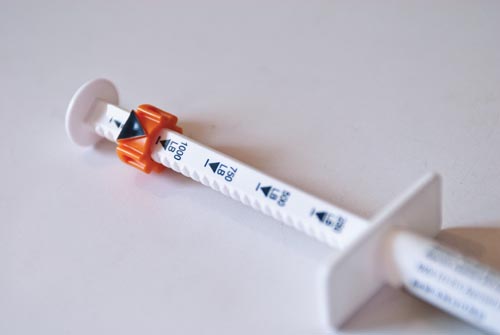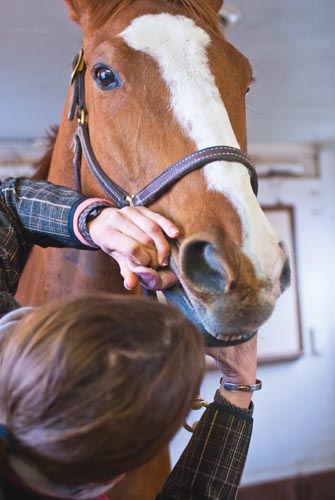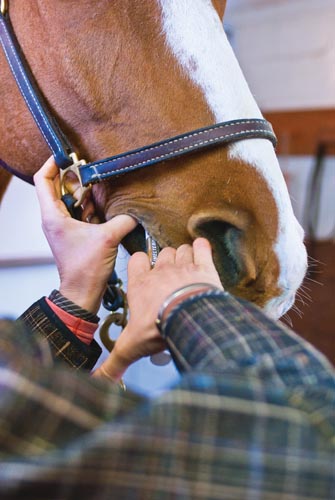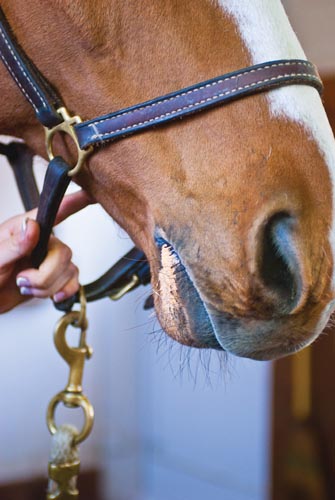Parasite control is a critical component of your horse's overall health-care plan. You probably have a system for what type of deworming products to give your horse and when, but it won't be effective if you can't get the correct dosage into him. With all but the most saintly of horses, administering paste dewormers without getting yourself and the stall splattered with paper-much-like goo takes a little strategizing.
In this article, I'll give a step-by-step plan for minimizing the mess and ensuring that your horse gets his full dose. Dr. Mary Griffin, DVM, a colleague in ambulatory practice with a specialty in ultrasonography in Chester County, Pennsylvania, is ?demonstrating the techniques I use.
How Much Is Enough?
1. Deworming medications are not effective when given in an inadequate dose, so always err on the side of giving more rather than less of the recommendation for your horse's weight. One easy way to estimate your horse's weight is with a weight tape, available through feed and tack stores. Also be aware that the average syringe contains enough medicine for a 1,200-pound horse, which is less than many of today's warmbloods weigh. So, if your horse is on the larger side, part of an additional syringe may be in order. Consult your veterinarian, who may suggest that, because deworming medications are very safe, even at higher-than-recommended doses, you should administer the dose for an additional 250 pounds (usually one mark on the syringe) more than you think your horse weighs.
When it comes to foals, smaller ponies or miniature horses, overdosing can become a problem, so you should always consult your vet before determining the appropriate dose, and be sure during the actual administering that an overdose does not occur.
2. It's also a good idea to have a little extra medication on hand, in case more ends up on the outsides of your horse's lips or on the ground than you expected. These drugs are not effective when given in small amounts over a period of time. The whole dose must be administered in one sitting. So if he doesn't swallow his full share within one day, wait a few days and start over with a new plan and another full dose.
Say Ahhhh!'
3. It's much easier for your horse to spit out the paste when he can combine it with a wad of food. So before administering the medication, check to be sure that he has no hay, grass or grain in his mouth. Holding the side of his halter with one hand, gently pull his lips back on the opposite side with a finger (being careful to keep it clear of his teeth) to check for food. Repeat on the other side of his mouth.
4. If you feel comfortable, encourage him to open his mouth by pressing a finger in the gap between his incisors and molar teeth, where the bit goes. On the opposite side and with your other hand, reach through the gap in the teeth to grasp his tongue. Gently pull it to the side and look into his mouth for food. Never apply excessive tension to the tongue, as it can result in permanent damage to the tongue's nerves. If your horse resents your pulling on his tongue, LET GO!
If you spot any food, this manipulation probably will compel him to finish chewing and swallowing it or spit it out in the next moment or two. Make sure there's no food available for him to grab. If he doesn't appear to be swallowing the food, carefully try to grasp the hay and remove it, steering clear of his teeth.
At this point, you should have a good idea of how your horse feels about having things put into his mouth. Most horses are fairly comfortable with the idea and, consequently, relatively easy to deworm. However, the occasional horse will take great exception to this process. Some hate it so much they're downright dangerous. Life's too short to risk your life for this simple purpose. If your horse throws his head violently or refuses to stand quietly, consider mixing his dose with food instead (see "Mix It Up" at left).
Down the Hatch
Where exactly you inject the medication depends on your horse. Some swallow it wherever you squirt it. Some do better if you put it on their tongues; others do better if you squirt it back between the cheek and molars. A few are so adept they spit it out regardless of where you put it. (For those types, consider mixing the dose with food.)
It may take some experimentation to find out which place works best for your horse. In any case, when you put the syringe in his mouth, be careful not to poke his lips or bump his teeth or gums, which can make the experience less pleasant for him?and harder to tackle the next time you deworm. Below are two techniques for administering the paste.
5. Begin by holding his halter with one hand and sliding the tip of the syringe gently into the corner of his lips, between his molars and incisors. Inject the paste directly onto the tongue, squeezing a small amount out at a time (leaving the syringe in his mouth as you pause), allowing your horse to swallow between or
6. slide the syringe back between the molars and cheek and squirt it toward the back corner of his mouth. Again, squeeze out only a small amount at a time. If you use this method, be especially careful to avoid bumping his teeth, which can be very annoying to most horses.
After completing her large-animal surgery residency and serving as a staff surgeon at the University of Pennsylvania's New Bolton Center in 1980, Midge Leitch, VMD, DACVS (Diplomate, American College of Veterinary Surgeons) opened a referral practice in which she developed a specialty in performance-limiting problems in racehorses and sporthorses. In the following decades, she traveled extensively with the US Equestrian Team, including trips to three Olympics and multiple World Championships. She returned to New Bolton Center in 2005 as a radiology clinician, assuming responsibility for equine diagnostic imaging, including digital radiography, MRI and CT.
Reprinted from the August 2011 issue of Practical Horseman magazine.















